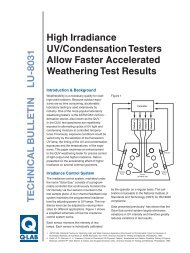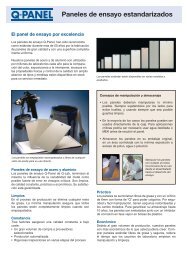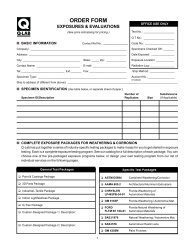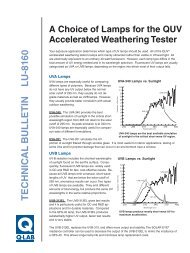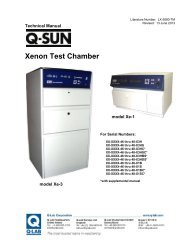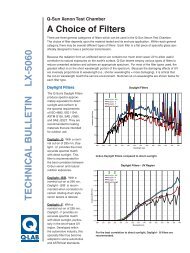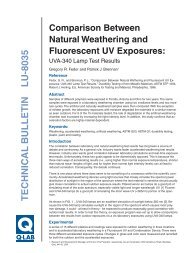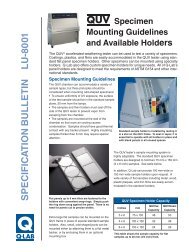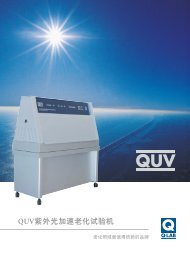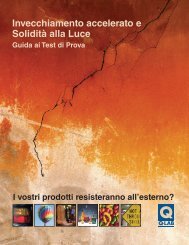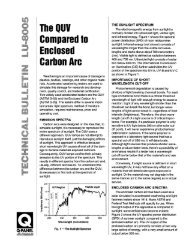Introduction to Cyclic Corrosion Testing - Q-Lab
Introduction to Cyclic Corrosion Testing - Q-Lab
Introduction to Cyclic Corrosion Testing - Q-Lab
You also want an ePaper? Increase the reach of your titles
YUMPU automatically turns print PDFs into web optimized ePapers that Google loves.
Acid Rain CCT<br />
This procedure, intended <strong>to</strong> simulate an acid<br />
rain exposure, is a modification of the Japanese<br />
Au<strong>to</strong>mobile Standards Organization (JASO) test<br />
method M609 for au<strong>to</strong>motive corrosion. Acid<br />
Rain CCT exposure conditions include:<br />
Electrolyte Solution 5% (wt) NaCl, 0.12%<br />
(vol) HNO3, 0.173%<br />
(vol) H2SO4, 0.228%<br />
(wt) NaOH<br />
Solution Acidity pH of 3.5<br />
The Acid Rain CCT exposure cycle is:<br />
2 hours Fog at 35°C<br />
4 hours Dry-off at 60°C,<br />
less than 30% RH<br />
2 hours Wet/humid at 50°C,<br />
over 95% RH<br />
Acid Rain CCT specifies transition times<br />
between environments as follows:<br />
Fog <strong>to</strong> Dry within 30 minutes<br />
Dry <strong>to</strong> Wet within 15 minutes<br />
Wet <strong>to</strong> Fog within 30 minutes<br />
Summary<br />
There are a large number of cyclic corrosion procedures<br />
<strong>to</strong> choose from. Each has advantages and<br />
limitations. Some researchers prefer fog environments<br />
<strong>to</strong> immersion. Some prefer specialized electrolyte<br />
solutions <strong>to</strong> simulate acid rain. Many prefer<br />
the advantages of au<strong>to</strong>mated chambers. The relative<br />
advantages of various exposure temperatures,<br />
durations, and sequences remain somewhat controversial<br />
and researchers will, no doubt, continue <strong>to</strong><br />
modify cycle times and adjust corrosive solutions.<br />
However, there is a strong consensus that, for most<br />
materials, cyclic corrosion testing gives more realistic<br />
results than traditional salt spray.<br />
Q-<strong>Lab</strong> Corporation www.q-lab.com<br />
Q-<strong>Lab</strong> Headquarters<br />
& Instruments Division<br />
Cleveland, Ohio 44145 USA<br />
Tel. +1-440-835-8700<br />
Fax +1 440-835-8738<br />
info@q-lab.com<br />
Q-<strong>Lab</strong> UK, Ltd.<br />
Bol<strong>to</strong>n, England<br />
Tel. +44 (0) 1204-861616<br />
Fax +44 (0) 1204-861617<br />
info.eu@q-lab.com<br />
Weathering Research Service<br />
Q-<strong>Lab</strong> Florida Q-<strong>Lab</strong> Arizona<br />
Homestead, Florida USA Buckeye, Arizona USA<br />
Tel. +1-305-245-5600 Tel. +1-623-386-5140<br />
Fax +1-305-245-5656 Fax +1-623-386-5143<br />
q-lab@q-lab.com q-lab@q-lab.com<br />
Q-<strong>Lab</strong> Germany / Q-<strong>Lab</strong> Deutschland GmbH<br />
Düsseldorf, Germany<br />
Tel. +49 (0) 211 50080255<br />
Fax +49 (0) 211 50657011<br />
info.de@q-lab.com<br />
Q-<strong>Lab</strong> China / 美国Q-<strong>Lab</strong>公司中国代表处<br />
电话:+86-21-58797970, +86-21-56030380<br />
传真:+86-21-58797960<br />
info.cn@q-lab.com<br />
LF -8144.1<br />
© 2009 Q-<strong>Lab</strong> Corporation.<br />
All Rights Reserved.



